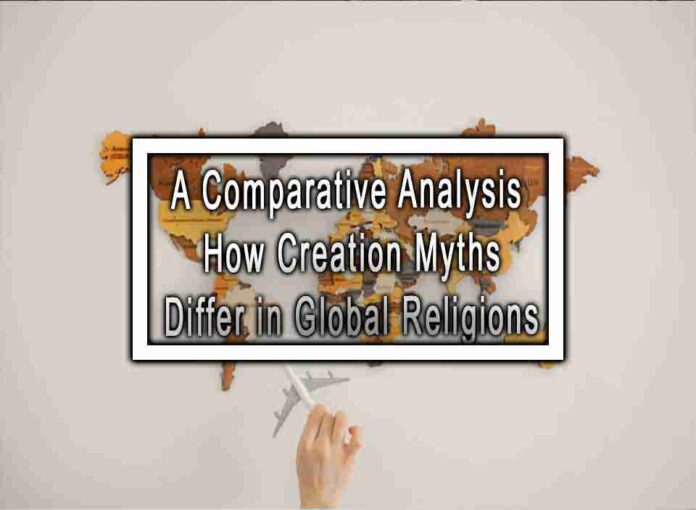Creation myths are narratives that explain the origin of the universe, the Earth, and humanity, and they vary significantly across different global religions. While each creation myth is unique to its respective culture and belief system, there are common themes and elements that can be observed in many of these stories. Here is a comparative analysis of how creation myths differ in global religions:
1. Cosmology and Creation:
Creation myths offer varying explanations for how the cosmos came into being. Some myths describe the universe as emerging from a primordial chaos or from the actions of gods or divine beings. For example, in Hinduism, the Rigvedic creation hymn “Nasadiya Sukta” contemplates the question of cosmic origin, while in Norse mythology, the cosmos is formed from the body parts of a giant.

2. Divine Beings and Gods:
Creation myths often involve the actions of deities or divine beings. These gods or goddesses may create the world intentionally or accidentally, and their personalities and motivations shape the characteristics of the created universe. In the Judeo-Christian tradition, the Abrahamic God is the central figure in the Genesis creation account.
3. Creation through Speech or Thought:
Some myths describe the world’s creation through the spoken word or divine thought. For instance, in the Hindu text “Brahma Vaivarta Purana,” Lord Brahma speaks the universe into existence, while in the Australian Aboriginal Dreamtime stories, the ancestral beings sing the world into being.
4. Symbolic Elements:
Creation myths often contain symbolic elements that represent fundamental aspects of reality or human existence. These symbols may include elements of nature, animals, celestial bodies, or archetypal figures. For example, the serpent is a common symbol in many creation myths, representing transformation and renewal.
5. Order and Chaos:
Creation myths often address the concept of order arising from chaos or the separation of primordial elements. The act of creation may involve organizing existing matter or separating opposing forces. In Ancient Egyptian mythology, the god Atum creates the world by bringing order out of chaos.
6. Human Creation:
Creation myths explain the origin of humanity and often involve the special creation of humans by the gods or the transformation of beings into humans. In some myths, humans are created in the image of the gods. For instance, in the Judeo-Christian tradition, humans are created in the image of God according to the book of Genesis.
7. Cultural Context:
Creation myths are shaped by the cultural context in which they originate. They often reflect the values, beliefs, and worldview of the societies that create and pass down these stories. As a result, creation myths from different cultures can provide valuable insights into the people’s understanding of the world and their place in it.
It is essential to approach the study of creation myths with cultural sensitivity and respect for the beliefs and traditions of the various communities that uphold these narratives. While there may be similarities and shared themes across different creation myths, each story is a vital part of the cultural heritage and religious identity of the people who hold them.










